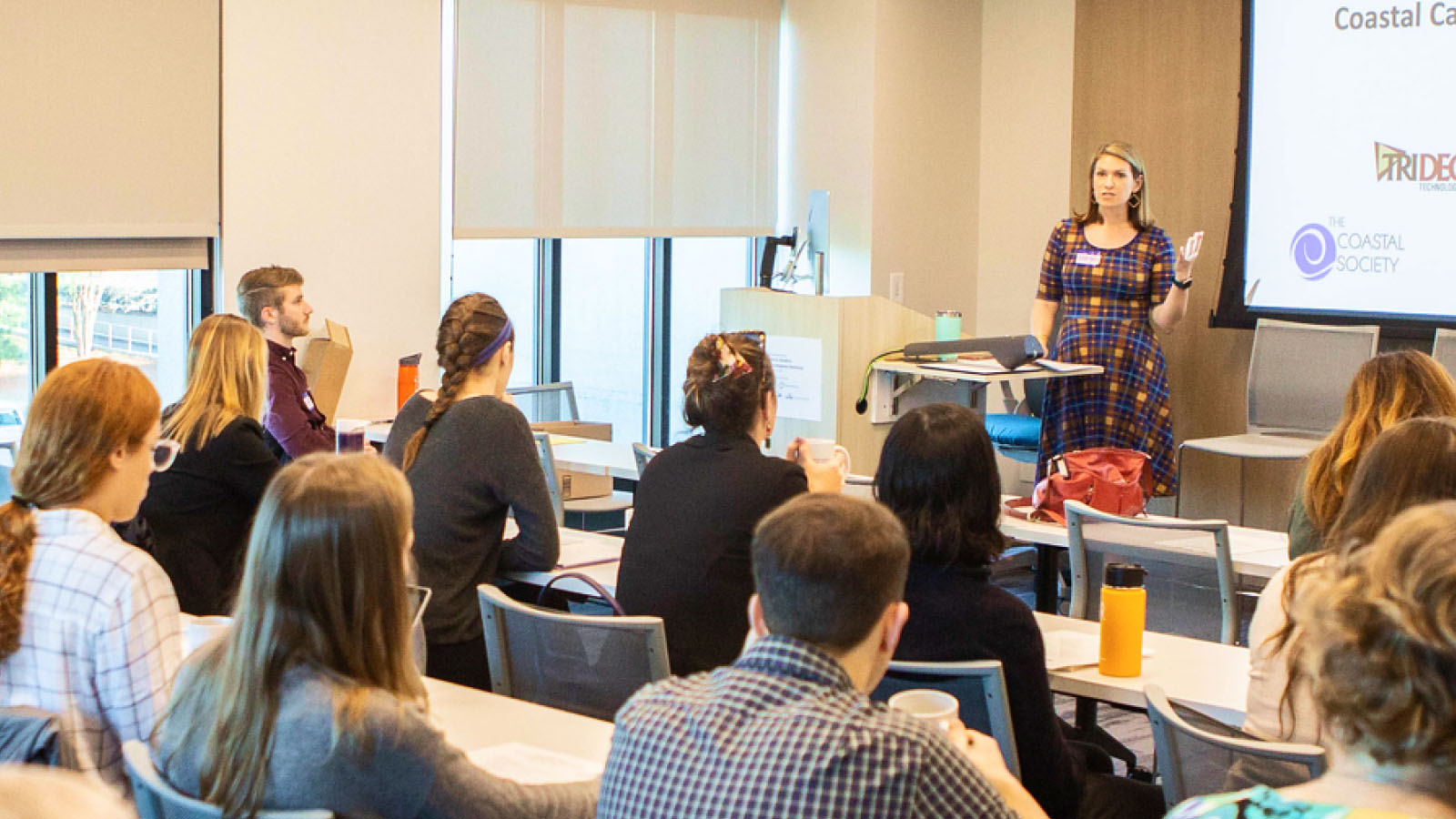The Takeaway: Partnerships between state coastal zone management programs and state departments of transportation for successful transportation planning in the coastal zone
Overview
A unique partnership between the California Coastal Commission and California Department of Transportation (Caltrans) streamlines transportation projects with positive environmental features along the California coast. Tami Grove, the commission’s transportation manager, describes how this partnership came to fruition and where it hopes to go in the future.
- Tami Grove, Statewide Transportation Program Manager at the California Coastal Commission

Lessons Learned
- Be open to unfamiliar partnerships. “Partnerships between coastal zone management programs and local transportation agencies are not ones we see too regularly. However, we see how mutually beneficial this 20-year partnership has been to California’s coast,” shares Tami.
- Institute a conflict resolution and communications strategy. Key parts of a successful, long-term partnership include conducting a review of how the agencies communicate, paying attention to what works and what doesn’t, attempting to resolve conflicts quickly, and instituting regular meetings and other check-in activities.
- Collaborate early and often. To avoid problems and unnecessary permit delays down the line, commission staff members collaborate early and often with Caltrans’ planning and engineering personnel to promote plans and designs that are consistent with coastal policies. This streamlined approach benefits both agencies.
- Find and highlight shared goals. While it may seem that there are more differences than similarities, highlighting shared missions and strategic plan goals helped both agencies find common ground.
- Think of the big picture. To really make an impact, partners must work from a corridor perspective—not simply on an individual, project-by-project basis.
- Programmatic approaches are key. Sharing information on best practices and designs helps support better projects and more programmatic permitting options. Permitting hurdles can be a barrier to techniques such as nature-based solutions. Tami wants to consider how to make permitting processes more clear and predictable for these types of projects, because doing so will make them more likely to be utilized by transportation agencies.
- Share the pride of results. Tami notes that innovative transportation projects with positive environmental outcomes require complex negotiations with local, state, and federal entities and a variety of stakeholders. All participants should be recognized and celebrated for their contributions toward successful results.
The Process
Twenty years ago, the California Coastal Commission and California Department of Transportation (Caltrans) took a chance on a unique partnership to improve coordination and design of transportation projects in a manner consistent with coastal policy requirements. The partners hoped that this interagency agreement would result in smoother permitting processes and improved transportation and environmental outcomes. At that time, many of Caltrans’ transportation projects were being denied—or approved with major redesign or large-scale mitigation requirements—resulting in much interagency friction, time sinks amid limited staff resources, and significant project-cost increases.
Caltrans and the commission initiated a cooperative agreement in which Caltrans provides funding resources to help with staffing capacity issues that previously inhibited engagement between the agencies. Having more needed staff members under their management allowed the commission to work with Caltrans on building an interagency team approach. This necessarily took patience, and improved communication, to build trust. Tami shared that investing the time to better understand each agency’s mandate, and finding “shared goals and opportunities while also reviewing barriers and underlying causes of conflict, ultimately brought success.”
The two agencies also put together an integrated planning team that included a Plan for Improved Agency Partnership. The team conducted statewide reviews to better understand what the agencies’ interactions were like, develop a crosswalk between both agencies’ strategic plans and goals, and gather suggestions for program improvements. In doing so, both agencies were able to identify their shared goals and opportunities to move California toward more sustainable transportation planning and design practices. Then the two agencies jointly developed workplans and initiatives focused on processes and products of mutual benefit.
According to Tami, it is not uncommon for transportation projects to overlook certain resource agency mandates, such as the protection of wetlands or agricultural lands, or public access to the coast. Projects might also overlook the development of appropriate mitigation strategies or the need to “factor in” effects of predicted sea level rise over the design life plans for the overall corridor.
Through the integrated planning team, staff members from the commission’s Statewide Transportation Program continue to collaborate with Caltrans in addressing such concerns early on in the planning and design process, which helps bring about speedier and more successful permit application reviews. “One measure of this success is that before our enhanced partnership, we had a number of permit appeals, but now, because we continue to work more effectively together earlier on in the transportation planning and project development processes, there hasn’t been an appeal brought by a commissioner in over a decade,” shares Tami.
The commission and Caltrans have agreed that highest-priority focus areas are (1) to improve understanding of transportation critical infrastructure vulnerabilities to sea level rise and (2) to adapt the transportation system effectively for greater resilience to those anticipated, changing conditions over the next century. One aspect is to look toward incorporating nature-based solutions that can enhance resource protection as part of adaptation strategies.
These new approaches to nature-based solutions are not yet well tested within West Coast environments and may face barriers that include perceived safety concerns or permitting challenges. Still, the commission hopes to work with various stakeholders to identify and encourage appropriate nature-based solutions in future transportation planning efforts. Over time, Tami believes, there could be increased opportunities to use these approaches in transportation strategies in a manner that protects coastal resources, particularly during some key phases of longer-term adaptation efforts.
For example, the commission often uses a phased approach that allows for interim measures protecting roadway infrastructure, while longer-term or more corridor-specific adaptation plans and projects can be designed and programmed for funding. The approach frequently includes “triggers” to put in place longer-term planning and implementation of sea level rise adaptation actions—prior to losing the existing infrastructure’s critical transportation functions. With clearer permitting pathways, demonstrated design performance, and resulting environmental benefits, transportation asset managers might more readily incorporate nature-based solutions into adaptation planning processes.
Outcome
One of the largest and most successful outcomes of the partnership between the California Coastal Commission and Caltrans is the San Diego North Coast Corridor Program. This program is providing a set of transportation, environmental, and coastal access projects. The commission approved the program’s federal consistency certification and local coastal-program amendments for the affected corridor cities. Integrated with this effort, the commission also approved the Public Works Plan/Transportation and Resource Enhancement Program. This program provides improvements for highway, rail, transit, bike/pedestrian, and coastal access, plus significant natural resource restoration, and mitigation efforts that include long-term lagoon restoration projects along the North Coast Corridor.
Caltrans is striving to better incorporate sea level rise data into their planning and analyses, which is a major accomplishment of the partnership. This effort facilitates Caltrans’ integration of scenario planning into project plans as early as possible, as part of their review criteria. One notable example of such sea level rise adaptation planning is the Gleason Beach Realignment Project, which was approved by the commission in fall 2020. This project, which is relocating an eroding section of Highway 1 between Bodega Bay and Jenner that is under extreme threat from sea level rise, will serve as a model of interagency coordination for managed retreat. Caltrans designed the project parameters in close coordination with Sonoma County and commission staff members to ensure the project package is consistent with California Coastal Act and local coastal program policies.
In addition to raising and relocating the highway eastward, to an area safe from hazards past the year 2100, the project includes an 850-foot bridge over Scotty Creek and adjacent wetlands, which is complete with bicycle lanes and a separated pedestrian walkway. The project also is improving riparian habitat and fish passage for Scotty Creek salmon by removing roadway fill. Furthermore, the project secured a beach parcel for public access in perpetuity and will construct a new segment of the California Coastal Trail. Another benefit of the project is a specialized in-lieu fee program. This fee program will be implemented by Sonoma County for removing damaged structures and associated rubble from homes and parts of the highway, along the beach and bluff, that previously succumbed to shoreline erosion.
Next Steps
Close coordination between the California Coastal Commission and Caltrans will continue, as transportation plans and projects are projected to increase dramatically in coming years. Through continuing, integrated planning team efforts and ongoing interagency agreements, the commission and Caltrans will work to further enhance coordination on key issues. These issues include adapting transportation infrastructure for sea level rise in ways that protect coastal resources; advancing multimodal transportation options; promoting advance habitat mitigation strategies; and developing guidance for training and programmatic approaches. Key focus areas will include coordinating reviews of the commission’s Sea Level Rise Adaptation Planning Guidance for Critical Infrastructure at Risk for Highways and Rail as well as the 2021 update of Caltrans’ Sea Level Rise Guidance.
